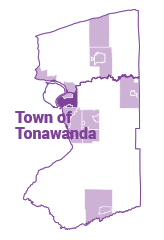Median Home Value, 2017
$124,200

With 73,000 residents and 33,000 jobs, the Town of Tonawanda is one of the region’s largest communities and employment centers. Yet more than a quarter of the population lives in or near poverty. Vulnerable groups in the town are less likely to be in poverty than elsewhere in the region. However, an aging population, a gap between worker skills and major employer needs, high rents, and reliance on automobiles all add to economic needs.
Click here to learn more about what living in or near poverty means for individuals and families.
Vulnerable populations, % living in poverty, 2017
Source: American Community Survey.
Source: American Community Survey.
Source: American Community Survey.
Source: American Community Survey.
Source: American Community Survey.
Source: American Community Survey.
| Rank | Employer |
|---|---|
| #1 | GM Powertrain |
| #2 | Caregivers Home Care |
| #3 | Sumitomo Rubber USA |
| #4 | Praxair Inc. |
| #5 | Kenmore-Tonawanda Union Free School District |
| #6 | DuPont |
| #7 | Tops Friendly Market |
| #8 | John W. Danforth Company |
| #9 | JD Supply |
| #10 | ABM Engineering Services |
Source: Various. See Data Sources and Notes.
| Town of Tonawanda | Buffalo Niagara | |
|---|---|---|
| Total Jobs | 32,964 | 547,851 |
| Earnings <$15k/yr | 9,112 (28%) |
150,324 (27%) |
| Earnings $15k-$40k/yr | 10,033 (30%) |
178,599 (33%) |
| Earnings >$40k/yr | 13,819 (42%) |
218,928 (40%) |
Source: US Census Bureau, LEHD.
$124,200
$792/mo



Over 200 human service providers and leaders use Numbers in Need to find information, build partnerships, pursue funding and advocate for their community.
“This data has been instrumental in finding what our community looks like and what obstacles we need to tackle to move ahead.”
“I have repeatedly and often share this data with colleagues and community members.”